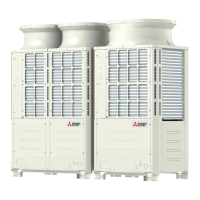What does Error Code 1500 mean on a Mitsubishi Electric PUHY-P168?
- NNathan WheelerSep 10, 2025
If your Mitsubishi Electric Air Conditioner is showing Error Code 1500, it indicates a refrigerant overcharge.

What does Error Code 1500 mean on a Mitsubishi Electric PUHY-P168?
If your Mitsubishi Electric Air Conditioner is showing Error Code 1500, it indicates a refrigerant overcharge.
What does Error Code 4220 or 4225 mean on my Mitsubishi Electric Air Conditioner?
Error Codes 4220 and 4225 on your Mitsubishi Electric Air Conditioner can indicate abnormal bus voltage drop or rise, a logic error, or low bus voltage at startup.
What does Error Code 7100 mean on Mitsubishi Electric PUHY-P168 Air Conditioner?
If your Mitsubishi Electric Air Conditioner is showing Error Code 7100, this indicates a total capacity error.
What does Error Code 7105 mean on a Mitsubishi Electric PUHY-P168 Air Conditioner?
If your Mitsubishi Electric Air Conditioner displays Error Code 7105, it means there is an address setting error.
What does Error Code 5301 mean on a Mitsubishi Electric PUHY-P168 Air Conditioner?
If your Mitsubishi Electric Air Conditioner is showing Error Code 5301, it indicates an ACCT sensor fault.
What does Error Code 6832 mean on a Mitsubishi Electric PUHY-P168 Air Conditioner?
If your Mitsubishi Electric Air Conditioner displays Error Code 6832, it indicates an MA remote controller signal transmission error (Synchronization error).
What does Error Code 2600 mean on a Mitsubishi Electric PUHY-P168?
If your Mitsubishi Electric Air Conditioner is showing Error Code 2600, it indicates water leakage.
What does Error Code 6606 mean on a Mitsubishi Electric PUHY-P168?
If your Mitsubishi Electric Air Conditioner displays Error Code 6606, it indicates a communication error between the device and transmission processors.
What does Error Code 7117 mean on a Mitsubishi Electric PUHY-P168 Air Conditioner?
If your Mitsubishi Electric Air Conditioner displays Error Code 7117, it indicates a model setting error.
What does Error Code 7113 mean on a Mitsubishi Electric PUHY-P168?
If your Mitsubishi Electric Air Conditioner displays Error Code 7113, it indicates a function setting error.
| Brand | Mitsubishi Electric |
|---|---|
| Model | PUHY-P168 |
| Category | Air Conditioner |
| Language | English |
Covers reading manuals, handling refrigerant leaks, and general warnings.
Details safe installation practices, cable usage, and electrical work requirements.
Lists necessary tools, materials, and specifies piping requirements and handling.
Covers brazing, air tightness tests, vacuum drying, and refrigerant charging procedures.
Explains refrigerant properties, composition, pressure, and notes on refrigerating machine oil.
Defines system compatibility, maximum cable lengths, and types.
Details DIP switch functions and address settings for system components.
Provides sample system connection diagrams and explains wiring methods.
Specifies allowable pipe lengths and sizes for various system configurations.
Identifies major components and shows refrigerant circuit diagrams for outdoor units.
Details the control board, INV board, fan board, noise filter, and transformer box.
Compares functions and specifications of MA and ME remote controllers.
Explains group settings, interlock settings, and using the built-in temperature sensor.
Provides the detailed electrical wiring diagram for the outdoor unit.
Shows the electrical wiring diagram for the transmission booster.
Illustrates refrigerant flow for PUHY-P72, P96, and P120 models.
Explains the function and specifications of key refrigerant circuit components.
Details DIP switch functions and factory settings for unit control.
Explains control methods, startup sequences, bypass control, and emergency operation modes.
Provides flowcharts for indoor and outdoor unit operation modes.
Outlines checks before and the method for performing a test run.
Covers refrigerant amount adjustment, calculation formulas, and standard operation data.
Lists and defines error codes, their causes, and troubleshooting steps.
Details troubleshooting for transmission issues, components like sensors, valves, fans, and inverter modules.
Explains how to interpret LED displays for various operating conditions and error codes.











